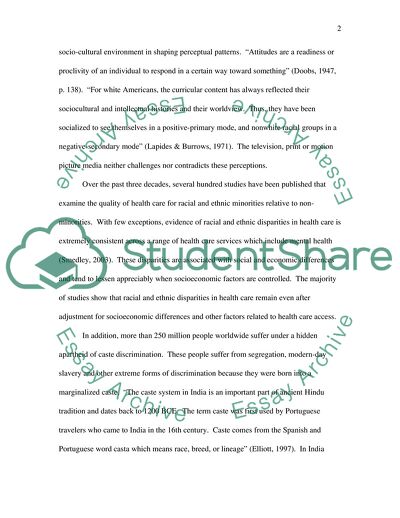
- Home
- Free Samples
- Premium Essays
- Editing Services
- Extra Tools
- Essay Writing Help
- About Us
- Studentshare
- Subjects
- Miscellaneous
- Racism in the world today a social problem
Racism in the world today a social problem - Essay Example

- Subject: Miscellaneous
- Type: Essay
- Level: Masters
- Pages: 4 (1000 words)
- Downloads: 0
- Author: agulgowski
Extract of sample "Racism in the world today a social problem"
Specifically, white racism subordinates members of all groups primarily because they are not white in color,” according to the definition provided by the U .S. Commission on Civil Rights (1970, p. 5). Racism permeates the family tree of societies and is reflected in all its attitudes, behavior, and institutions. The concept of racism may be conscious or subconscious and is expressed in actions or attitudes initiated by individuals, groups, or institutions that treat human beings unjustly because of their skin pigmentation.
It is rooted in dysfunctional belief systems resulting from distorted perceptions formed over a period of time. We cannot ignore the significant role of the socio-cultural environment in shaping perceptual patterns. “Attitudes are a readiness or proclivity of an individual to respond in a certain way toward something” (Doobs, 1947, p. 138). “For white Americans, the curricular content has always reflected their sociocultural and intellectual histories and their worldview. Thus, they have been socialized to see themselves in a positive-primary mode, and nonwhite racial groups in a negative-secondary mode” (Lapides & Burrows, 1971).
The television, print or motion picture media neither challenges nor contradicts these perceptions. Over the past three decades, several hundred studies have been published that examine the quality of health care for racial and ethnic minorities relative to non-minorities. With few exceptions, evidence of racial and ethnic disparities in health care is extremely consistent across a range of health care services which include mental health (Smedley, 2003). These disparities are associated with social and economic differences and tend to lessen appreciably when socioeconomic factors are controlled.
The majority of studies show that racial and ethnic disparities in health care remain even after adjustment for socioeconomic differences
...Download file to see next pages Read MoreCHECK THESE SAMPLES OF Racism in the world today a social problem
Racism in America Today
Constructions of Race in Culture and Politics
Racism, a Societal Shame
Racism in Britain
The Problem of Racism in Football Matches
Constructions of Race in Culture and Politics
Social Problems Due to Racism
Towards the Understanding of Racism

- TERMS & CONDITIONS
- PRIVACY POLICY
- COOKIES POLICY